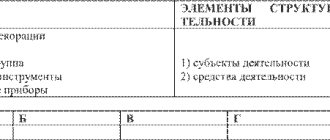“Who am I?”, “What am I?”, “Where are ours and where are our strangers?”, “Am I the same as who?” - questions that sooner or later every person asks himself. Self-determination is one of the most difficult problems in psychology. In science this is called identity. Derived from the Latin identitas, which means “identical, identical.” Why personal identity is important, what it is and what it is responsible for, why its loss is dangerous - let’s figure it all out in order.
Identification and self-identification
The concepts of identity and identification are especially important to distinguish when studying intergroup relations. They are close in meaning, but differ significantly as scientific terms. Identification in a general sense is the likening of something to something. In the humanities and social sciences, in particular in psychology, various types of identification are distinguished. For example, it is often defined as establishing the identity of an unknown material object with an already known object based on the coincidence of certain significant features. There is also such a thing as personal identification, or self-identification. This is the individual’s established attitude towards himself.
Sigmund Freud, the founder of psychoanalysis, first introduced the concept of identification. However, it is in social psychology that it has become most widespread. Freud originally viewed identification as an unconscious process of imitation. He believed that this is one of the ways to psychologically protect the individual. In social psychology, it is believed that identification is an important condition for socialization, the assimilation by a person (primarily this applies to children) of patterns and patterns of behavior in society. As a result of socialization, the individual accepts his social roles. He realizes that he belongs to a certain group (age, professional, religious, political, racial, ethnic), whose norms must be followed.
Identification mechanisms in psychology
Identification mechanisms come in various forms. For example, imitation, identification, immersion in the world of another person, the potential opportunity to do so, and so on.
We dissolve into each other.
The entire internal and external world of a person can be identified: worldview, character traits, motives, interests, goals, and even manners of behavior and communication.
If you haven’t seen a friend for a long time, but have a good memory and observation skills, you may notice how, for example, he began to do things unusual for him - fiddling with his lips, squinting or speaking through his nose. Ask who of his friends does this, and you will find out the name of the person he is targeting.
Concept of identity
Identification in modern terminology is a phenomenon that we observe as if from the outside. In this case, we can state the presence of a certain process and determine its result. There is also such a thing as identity. It refers to the state of an individual's inner world. This is a subjective attribution of oneself to a certain social group (class, type, species). So, identity in its most general form is the identification of a person with others.
Henry Tajfel's Personality System
Henry Tajfel, an English psychologist, is the creator of social identity theory. He made significant contributions to the study of the psychology of relations between groups. In accordance with the theory of Henry Tajfel, one can imagine the “I-concept” of an individual as a system that regulates all kinds of forms of social behavior. This system includes two subsystems. The first of these is personal identity. It is responsible for how a person defines himself; it is a set of individual intellectual, physical, moral and other characteristics of a person. The second subsystem is group identity. She is responsible for assigning an individual to professional, ethnic and other groups. The transition taking place in human consciousness from personal to group identity corresponds to the transition from various forms of interpersonal social relations to intergroup relations, and vice versa.
Tajfel's works have become widespread among scientists. In addition, in social psychology they gave rise to a discussion about the relationship between personal and social identity. This debate continues to this day.
How to write a term paper on speech therapy
07.09.2010 257518
These guidelines are compiled to help students gain an understanding of the content and structure of coursework in speech therapy.
Logopedia of pedagogical science that studies anomalies of speech development with normal hearing, explores the manifestations, nature and mechanisms of speech disorders, develops the scientific basis for overcoming and preventing them means of special training and education.
The subject of speech therapy as a science is speech disorders and the process of training and education of persons with speech disorders.
The object of study is a person suffering from a speech disorder.
The main task of speech therapy as a science is the study, prevention and elimination of various types of speech disorders.
Coursework in speech therapy is a student's scientific and experimental research. This type of educational activity, provided for by the educational and professional program and curriculum, contributes to the acquisition of skills in working with literature, analyzing and summarizing literary sources in order to determine the range of insufficiently studied problems, determining the content and methods of experimental research, processing skills and qualitative analysis of the results obtained. The need to complete coursework in speech therapy is due to the updating of knowledge concerning the content, organization, principles, methods and techniques of speech therapy work.
As a rule, during their studies, students must write two term papers - theoretical and practical.
The first course work should be devoted to the analysis and synthesis of general and specialized literature on the chosen topic. Based on this analysis, it is necessary to justify and develop a method of ascertaining (diagnostic) experiment.
In the second course work, it is necessary to provide an analysis of the results obtained during the ascertaining experiment, as well as determine the directions and content of speech therapy work, and select adequate methods and techniques of correction.
So, let’s present the general requirements for the content and design of coursework in speech therapy.
The initial and most important stage of working on a course project is the choice of a topic, which is either proposed by the supervisor or chosen by the student independently from a list of topics that are consistent with the areas of scientific research of the department.
Each topic can be modified, considered in different aspects, but taking into account a theoretical and practical approach. Having chosen a topic, the student needs to think through in detail its specific content, areas of work, practical material, etc., which should be reflected both in the formulation of the topic and in the further construction of the study. It should be recalled that the chosen topic may not only have a purely theoretical orientation, for example: “Dysarthria. Characteristics of the defect”, “Classification of dysgraphia”, but also take into account the practical significance of the problem under consideration, for example: “Speech therapy work on speech correction for dysarthria”. It should also be taken into account that when formulating a topic, excessive detail should be avoided, for example: “Formation of prosodic components of speech in preschoolers of the sixth year of life attending a preschool institution for children with severe speech impairments.”
The course work includes such mandatory parts as: introduction, three chapters, conclusion, bibliography and appendix.
The text of the term paper begins with the title page . An example of its design can be seen here.
Then the content of the work is given, in which the names of chapters, paragraphs, and sections are formulated in strict accordance with the content of the thesis. An example of its design can be seen here.
In the text, each subsequent chapter and paragraph begins on a new page. At the end of each chapter, the materials are summarized and conclusions are formulated.
The introduction reveals the relevance of the problem under consideration in general and the topic being studied in particular; the problem, subject, object, and purpose of the study are defined. In accordance with the goal and hypothesis, objectives and a set of research methods aimed at achieving the objectives must be defined.
The relevance of the topic lies in reflecting the current level of pedagogical science and practice, meeting the requirements of novelty and usefulness.
When defining the research problem, it is important to indicate what practical tasks it will help to implement in training and educating people with speech pathology.
The object of research is understood as certain aspects of pedagogical reality, perceived through a system of theoretical and practical knowledge. The ultimate goal of any research is to improve this object.
The subject of research is some part, property, element of an object, i.e. the subject of research always indicates a specific aspect of the object that is to be studied and about which the researcher wants to gain new knowledge. An object is a part of an object.
You can give an example of the formulation of the object, subject and problem of research:
– The object of the study is the speech activity of preschool children with phonetic-phonemic speech disorders.
– The subject of the study is the features of intonation speech of children with phonetic-phonemic speech disorders.
– The research problem is to determine effective directions for speech therapy work on the formation of intonation expressiveness of speech in the system of correctional intervention.
The purpose of the study contributes to the specification of the object being studied. The goal of any research is to solve a specific problem. The goal is specified in tasks taking into account the subject of research.
The research objectives are formulated in a certain sequence, which determines the logic of the research. The research objectives are set on the basis of a theoretical analysis of the problem and an assessment of the state of its solution in practice.
The first chapter is an analysis of literary sources, which examines the state of this problem in historical and modern aspects, and presents the most important theoretical principles that formed the basis of the study.
When writing the first chapter, you should pay attention to the fact that the text of the course work must be written in a scientific style. When presenting scientific material, it is necessary to comply with the following requirements:
– Specificity – a review of only those sources that are necessary to disclose only a given topic or solve only a given problem;
– Clarity – which is characterized by semantic coherence and integrity of individual parts of the text;
– Logicality – which provides for a certain structure of presentation of the material;
– Reasoning – evidence of thoughts (why this and not otherwise);
– Precision of wording, excluding ambiguous interpretation of the authors’ statements.
A literary review of the state of the problem being studied should not be reduced to a consistent presentation of literary sources. It should present a generalized description of the literature: highlight the main directions (currents, concepts, points of view), analyze in detail and evaluate the most fundamental works of representatives of these directions.
When writing a work, the student must correctly use literary materials, make references to the authors and sources from which the results of scientific research are borrowed. Failure to provide required references will reduce your coursework grade.
As a rule, in coursework on speech therapy, references to literary sources are formatted as follows: the number of the cited source in the general list of references is placed in square brackets. For example: General speech underdevelopment is a speech pathology in which there is a persistent lag in the formation of all components of the language system: phonetics, vocabulary and grammar [17].
When using quotations, in square brackets, in addition to indicating the source number, the page number from which this excerpt is taken is indicated, for example: Speech rhythm is based on a physiological and intellectual basis, since, firstly, it is directly related to the rhythm of breathing. Secondly, being an element that performs a communicative function, “correlates with meaning, i.e. controlled intellectually” [23, P.40].
However, course work should not be of a purely abstract nature, so you should not abuse the unreasonable abundance of citations. Quoting should be logically justified, convincing and used only when really necessary.
In the second chapter , devoted to experimental research, the organization should be described and the program of the ascertaining experiment should be presented. The survey methodology, as a rule, consists of a description of several series of tasks, with detailed instructions, visual and lexical material, the procedure for completing tasks by experiment participants, and scoring criteria. This chapter also provides a qualitative and quantitative analysis of the results obtained.
When analyzing the results of an experiment, it is necessary to use a scoring system. Examples of various criteria for quantitative and qualitative assessment are presented in the following works:
– Glukhov V.P. Formation of coherent speech in preschool children with general speech underdevelopment. - M.: Arkti, 2002. - 144 p.
– Fotekova T.A. Test methodology for diagnosing oral speech of primary schoolchildren. - M.: Arkti, 2000. - 56 p.
– Levchenko I.Yu. Pathopsychology: Theory and practice. - M.: Academy, 2000. - 232 p.
In order to visually present the results obtained during the experimental study, it is recommended to use tables, graphs, diagrams, etc. Histograms can be used in a variety of ways - columnar, cylindrical, planar, volumetric, etc. An example of the design of tables, figures, and histograms can be found here.
The third chapter provides a rationale for the proposed methods and techniques and reveals the content of the main stages of correctional work.
The conclusion contains a summary of the material presented and the main conclusions formulated by the author.
The bibliography must contain at least 25 sources. The list includes bibliographic information about the sources used in preparing the work. An example of its design can be seen here.
In the application you can present bulky tables or illustrations, examination protocols, observation records, products of activity (drawings, written works of children), notes from speech therapy classes, etc.
The volume of one course work must be at least 30 pages of typewritten text.
In general, coursework in speech therapy is the basis for a future thesis, in which the study of the begun problem can be continued, but from the standpoint of a different approach or a comparative analysis of the disorders being studied in different age categories of people with different types of speech disorders.
The content and format of theses in speech therapy can be found here.
Literature:
1. How to write a term paper on speech therapy: Methodological recommendations. Educational and methodological manual / Comp. Artemova E.E., Tishina L.A. / Ed. Orlova O.S. – M.: MGOPU, 2008. – 35 p.
2. Research work of students in the system of higher professional pedagogical education (specialty 031800 - Speech therapy). Methodological recommendations for completing the thesis / Compiled by. L.V. Lopatina, V.I. Lipakova, G.G. Golubeva. - St. Petersburg: Publishing house of the Russian State Pedagogical University named after. A. I. Herzen, 2002. - 140 p.
Personal and social identity
Self-identity is a concept that, in the traditional sense, is a set of individual characteristics that distinguish a particular person from other people. As for social identity, it is often considered as the result of an individual’s awareness of his belonging to certain social groups. In the process of this awareness, a person acquires characteristics characteristic of these groups. It should be noted that, both at the empirical and practical levels, it is sometimes difficult to distinguish between concepts such as personal and social identity. Researchers are often forced to think about what they are dealing with.
Identification in criminology
Criminologists understand identification as the identification of a wanted criminal. In the process of operational-search activities (OPM), specialists use several identification methods at once.
Identification in criminology is the identification (establishment) of a person based on dynamic and static characteristics. The first includes facial expressions, speech, gestures, and gait. The second includes fingerprints, smell, composition of biological fluids. Sometimes for identification they use a sketch compiled from the words of witnesses, a photograph or a computer model of a person.
Conditions for the identification procedure:
- Preservation of the rights and freedoms of all participants.
- Maintaining the safety of witnesses, maintaining secrecy.
- Drawing up a report, extract, certificate on the results of the event.
- The final document describing the conditions under which identification took place and the signs of compliance. Audio, video and photographic materials are included.
Personal identification can take place in natural or artificial conditions. That is, in those places where the suspect should appear or at the police department.
Types of social identity
The term “identity” is used very widely in modern humanities and social sciences. It should be understood that this is not a property that is inherent in the individual. Identity is a person’s attitude towards himself in the world, formed and developed over time in the conditions of interaction with people. A number of psychologists believe that it is inherent only in individual subjects. They believe that identity can only be attributed to groups in a metaphorical sense.
Scientists talk about ethnic, professional, political, regional, age, gender identity, etc. The types can change, since the meaning of each of them in the personality structure is different. This depends on temporary and situational factors, such as a person’s place of residence, his type of activity, age, education, worldview, etc.
Stages of ego identity formation
Ego identity already appears in infants, but it is not yet formed. According to Erikson, as a person grows older, he goes through 8 stages of development. At each of them, he solves his own psychosocial problems, he develops different personal qualities.
The transition from one stage to another is accompanied by crises, the successful completion of which helps the child acquire important life skills. And each period influences ego identity in its own way.
Erik Erikson's theory of personality development
The age to which one or another stage is attributed is arbitrary. Everything is individual and depends on the speed of personal development, as well as the requirements placed on it by society.
- Infancy: 0-1 year
This is the time when basic trust or distrust in the world is formed. The child subconsciously determines what environment he lives in: is it safe, can people around him be trusted, what should he expect from the world. This is how optimism or pessimism is formed as part of the Ego.
- Early childhood: 1-3 years
Formation of independence or dependence. If a child is allowed to do everything on his own, then he grows up with self-confidence and willpower. If not, in adult life you always feel shame, doubt, and are dependent on others.
- Play age: 3-6 years
If parents encourage the child’s desires and initiative, then such qualities as determination and enterprise become part of his ego. If not, then the person begins to imitate others, follow other people’s goals, and often feel guilty.
- School age: 6-12 years
A feeling of competence in something is formed, confidence that a person will cope with the task. Or there will be a lack of faith in one’s strength, a feeling of inferiority.
- Youth age: 12-20 years
This is the most important period for the formation of ego identity. The teenager realizes that there are many roles in the world. And his views are different from the views of other people. He begins to imitate authorities, significant adults, and peers.
A teenager understands himself in the context of the social connections that he builds. The main task of this period is to collect all the roles into a single whole. Discard some, and integrate others so that he develops a holistic image of himself.
If the previous periods were successful, he developed:
- trust in the world;
- self confidence;
- initiative;
- independence.
This means that in adolescence the chance of gaining personal integrity is much higher. This is the time when a teenager tries to understand himself, realize his abilities, and choose a path in life.
Erickson is sure that the teenage period is one of the most significant. It plays a key role in the formation of ego identity.
- Early maturity: 20-25 years
A feeling of closeness, intimacy, and the ability to be in emotional contact is formed. If the ego identity has not been formed, loneliness, isolation, and lack of understanding of what a person wants in this life sets in.
- Average maturity: 25-65 years
This is a time for self-realization, professional achievements, gaining social status, and creative activities. But with unsuccessful passage of the previous stages, a feeling of emptiness, stagnation, and indifference sets in.
- Late maturity: from 64 years old
At this stage, the final formation of ego identity occurs. A person looks back at his life and either experiences a feeling of satisfaction, confidence, awareness of himself as an individual, an understanding of “who I am.”
Or regret sets in. Understanding that life has been lived in vain and that it is too late to start anything. This is often accompanied by a withdrawal of responsibility for one’s decisions and actions, and a refusal to admit one’s mistakes.
In such a scenario, we can say that the person has never formed personal integrity, that is, ego identity.
Ethnic identity
It can be activated or faded as a result of a change in a person’s attitude towards the national community to which he belongs. Most often, ethnic identity does not develop as a result of “attribution” by other people of a certain national characteristic (although this also happens). It usually appears in the process of awareness and individual self-determination. For example, if a person’s surname has obvious ethnic characteristics, this does not mean his identity. This is not enough for an individual to self-determinate as a representative of a certain nationality, although this also occurs in a society characterized by obvious ethnic contradictions.
What does the concept of identification include?
Identification is the identification of oneself with another person, character or even a group of people, as well as further unconscious assimilation.
A person lives in society and encounters other “characters” in whom he sees traits and qualities that are not characteristic of him. To make communication easier, a person takes on some characteristics. The more we come into contact with a certain person, the more we absorb from him. This is a defense mechanism that allows you to avoid conflicts. This is relative to other people.
When we look inside ourselves, we can see many people.
You can identify yourself not only with a real person. Some qualities are adopted from books. The human psyche is aimed at constant self-improvement; we unconsciously strive to become better, and for this we need to have an idea of the ideal. These may be in books.
Identification can also be cultural, ethnic, collective, but I would like to start, of course, from childhood.
Gender identity
It is created in early childhood during human biological development. Apparently, it can be determined not only by biological factors, but also by social ones. For example, non-traditional sexual orientation (sexual identity) is a very difficult phenomenon to understand, since in society today there is an active struggle to determine the norms and conditions of gender identity. This problem cannot be solved within the framework of social psychology. It requires a systematic analysis involving the opinions of a large number of specialists - cultural scientists, biologists, psychiatrists, lawyers, etc. The individual and the group are currently forced to compromise, since a person’s non-traditional social identity causes discomfort to many members of society.
Professional identity
Another important task facing an individual at a certain stage is the formation of a professional identity. Scientists often talk about professional self-determination. This process does not end in adolescence after choosing a profession or receiving an education. A person is very often forced to self-determinate in his activities throughout his life. This depends not only on the individual himself, but also on external circumstances. An example is economic crises. As a result of these crises, some professions become unnecessary, while others become more in demand. A person is forced to adapt to the changed labor market.
Social groups as subjects and objects of social identification
Social identity is a concept that in modern social psychology is central to understanding the specifics of intergroup relations. After all, this is the key point that unites the individual and the group to which she belongs. It should be noted that social groups in society are an extremely heterogeneous phenomenon. It is therefore important to define what we mean by this term.
These associations of individuals are distinguished according to a variety of characteristics and parameters, despite the fact that there are common characteristics of the social group. Therefore, it would be logical to assume that the process of social identification in its specificity is determined by the properties of the groups to which a given person belongs.
The characteristic features of a social group are as follows:
- a certain way of interaction of its members, which is determined by a common cause or interests;
- awareness of membership in a given group, a sense of belonging to it, manifested in protecting its interests;
- awareness of the unity of the representatives of this association or the perception of all its members as a single whole, not only by them, but also by the people around them.
Identification in Freudian philosophy?
The famous Austrian expert on psychoanalysis, Sigmund Freud, created his own concept of this phenomenon. He was the first to identify the following categories of identification:
1. Anaclitic
This type of mental reaction is characteristic of children who identify themselves with a parent who supports and helps them. For example, if a mother shows maximum attention and tenderness towards her child, then the child will ultimately want to be just like her.
2. Identification with the aggressor
The Austrian psychologist viewed this category as an automatic reaction caused by the need for protection from the influence of a person with more power. So, if a child is afraid of his father’s punishment, he subconsciously strives to become like his parent. In this case, the child thinks, he will have the same influence and the same power.
In psychological practice, there are often cases when a patient identifies himself with the specialist treating him. Freud warned his colleagues against the narcissistic temptation to imagine themselves as the all-powerful “saviors” of their clients. Despite this, this taboo continues to be violated more often than other therapeutic prohibitions.
Conclusion
Identification gives us the opportunity to better understand other people by putting ourselves in their place. Many phenomena of the surrounding world are difficult to perceive individually. A person needs to compare himself with a specific image, which is achieved through identification.
Group status and social identity
Scientists have noted that those who belong to high-status social groups tend to think less about group membership than those who belong to low-status social groups. The fact is that membership in such elite associations of individuals is a certain standard. Other social groups compare their identity with this standard.
Membership in stigmatized, discriminated against, low-status groups leads to the emergence of a negative social identity. In this case, individuals often resort to special strategies. Using various means, they achieve a positive social identity of the individual. They either seek to leave that group and join a more highly regarded one, or to have their group perceived more positively.
As you can see, the formation of social identity is a complex and multifaceted process. It certainly requires further study.
Empathy
Over time, a person will move away from his parents and may adopt the behavior and character traits of literary heroes. Bravery in extreme situations, honesty, valor, etc. can be the merit of the books on which a child or teenager was raised. I have a separate article about what empathy is.
The impact of films is weaker, since the period of their influence on the human psyche is short-lived. Identifying with the hero of a work of art helps to better understand the work and evokes vivid emotions and experiences.
At a young age, many girls show a penchant for reading romantic literature. From books they learn more about how true ladies behave, as a result of which they themselves develop such traits as morality, delicacy, and femininity.
You can use the desire for identification for your own purposes. For example, during a divorce, it is recommended to read books about strong women, or heroic epics to develop self-confidence.
By the way, all this is written very interestingly in Yulia Fomina’s book “Psychological characteristics of fairy-tale characters and personal identification.” It tells exactly how fairy tales influence a child and what consequences they lead to in adulthood. Who knows, maybe in this work lies the answer to the question: “Why am I like this?”








